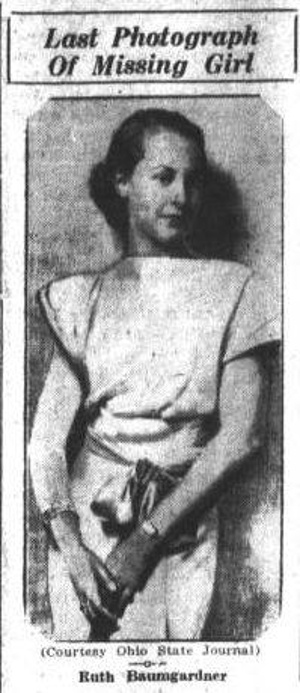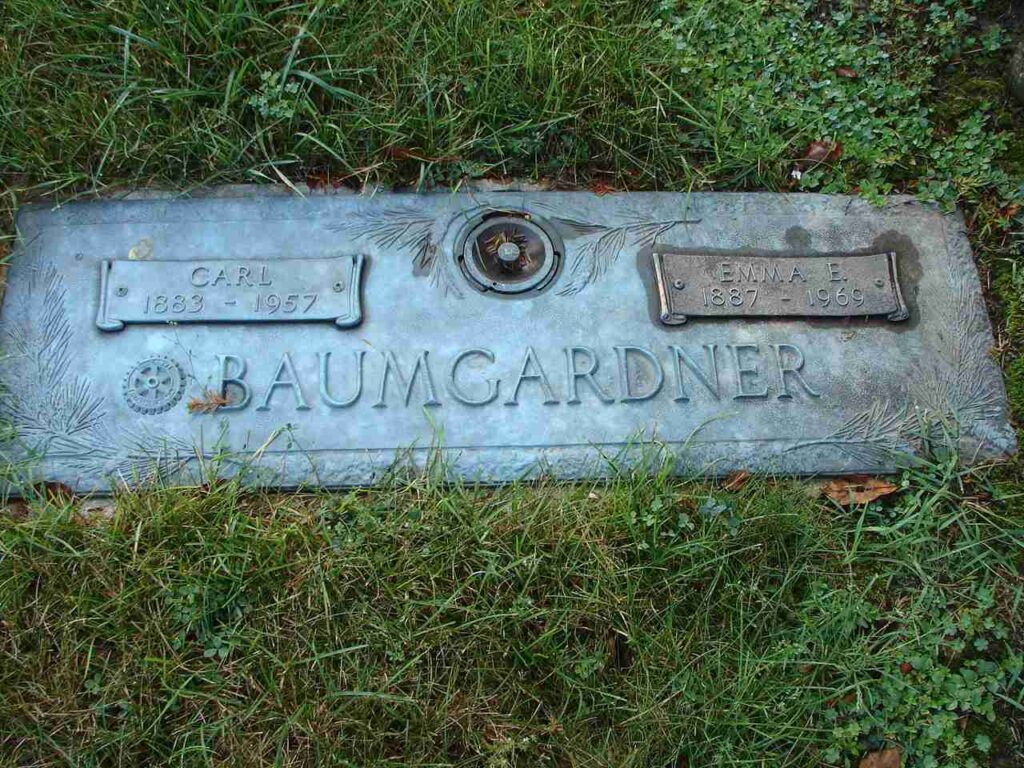Ruth Baumgardner was, according to the vast majority of newspaper and magazine articles written about her, a very pretty young woman. In 1937, Ruthie was a senior at Ohio Wesleyan University in Delaware, Ohio (otherwise, her home was in the Lakewood suburb of Cleveland). Most people found Ruthie to be personable, friendly even, and there wasn’t much anyone could say negatively about her. She was a member of the Delta Delta Delta sorority, or the Tri-Delts as they liked to call themselves.
On campus, Ruthie lived in Austin Hall’s room 319, which was one of the dormitory’s few single-occupant rooms. Several girls who knew her did say she kept her room clean, but messy and disorganized. So, maybe it was good she didn’t have a roommate to complain her bed was never made, or how nothing was ever put away or tidied up.
Ruthie came from a rather affluent family and seemed to get along with them just fine. In fact, her father had just given her a brand new, fiery red Dodge convertible as an early graduation gift.
If Ruthie had any major problems, she never let on to them. Or, maybe she did. In a letter written to her father, she had expressed a bit of frustration over how much work she was doing for her studies, plus all the other extracurricular activities she had signed up for, such as a singing competition many felt she had a good chance of winning. It was getting to be too much, she had said. Her father offered her words of encouragement, which seemed to settle things at the time.
Tuesday, May 4, 1937
Throughout the day of Tuesday, May 4, 1937, everything in the life of Ruthie Baumgardner seemed normal. That morning, she had attended classes and seemed jovial, according to her fellow students. She practiced for that singing competition in the afternoon. After supper she returned to her room to study. At nearly eleven o’clock, Ruthie appeared at the dormitory’s Smoking Room in a dressing gown with her hair in curlers. She sat and chatted for a bit with several other girls, and then left.
Nobody had any sense that anything was wrong. There was no drama. It was just another ordinary day.
Wednesday, May 5, 1937
The following evening, someone noticed that Ruthie wasn’t at dinner and began asking around if anyone had seen her. No one had. And once they determined that nobody had seen Ruthie at all that day, not in class, not around the dormitory, not around campus, fear crept in that something was wrong.
Campus security was alerted and began to investigate the matter themselves. The first thing they thought to do was to check out Ruthie’s room. As soon as they entered, they saw that the whole room had been tidied up, the bed was made, things had been cleaned. This was so unlike Ruthie that her friends now really started to think something had happened to her. But, to campus security, there were no signs of foul play.
On a little stoop just outside her door, they discovered Ruthie’s dorm room keys.
After checking her room, they ventured downtown to the garage where Ruthie had kept her new car, where they found it parked in its usual spot. Once again, there was nothing odd found in or around the car, except that the keys had been left in the ignition.
Returning to campus, security made a determination. Ruthie left on her own accord. There was no evidence that she had been harmed, or coerced or that anything bad had happened to her. However, since nobody knew where she was, they did consider her to be a missing person and in the late evening, campus security called the local police station and reported Ruth Baumgardner as missing.
Thursday, May 6, 1937
There was one event that occurred on May 6, 1937 that would capture the world’s attention. I am of course referring to the day that The LZ 129 Hindenburg exploded in Manchester County, New Jersey (Oh, the Humanity). As far as a little investigation into a missing Ohio Wesleyan University student, there wasn’t much to note.
The local police, it seems, had pretty much solved the case the instant the student had been reported missing.
She has amnesia, they said. She’ll be back when her memory recovers, they said.
(Yep! That was their theory.)

Theories and Investigations
Emma and Carl Baumgardner hired a Pinkerton Detective to investigate their daughter’s disappearance, perhaps because local law enforcement did not want to look past that whole “she temporarily forgot who she was” theory, although they also suggested that she might have run off with an unknown boyfriend that her family, her fiance, nor all her friends and fellow students knew anything about.
While I have seen no detailed report from the Pinkerton detectives, their names have appeared from time to time in police reports and newspaper articles, so it’s unclear what roles they played in any of the events, or whether later police actions were on account of pressure from them or if the cops were just being diligent while also believing the amnesia theory.
There are many theories about what happened to Ruth Baumgardner … some good and some … well …???
Theory: Amnesia
We can really only speculate how and why the police came up with this theory. Is it possible they only said this because they were lazy and didn’t want to investigate? Sure, that’s a possibility, I suppose. Or, there could be another explanation.
Young adults “going missing” from college or university campuses isn’t exactly as rare as we think (or hope) it is. While it’s rare for students to pack up their bags and go somewhere else this close to graduation, it has happened before (and probably will again). And, most of the time when this happens, there is an obvious (even if just in retrospect) explanation. Even though Ruthie had expressed her frustration over such a heavy burden school and other activities were having on her, there simply wasn’t enough to support the idea that she would just walk off (although, lacking additional evidence, it still might be possible.)
In some of these similar cases, when a student would show up, usually within a week or two, after “disappearing”, it was sometimes explained away by “amnesia”. Personally, I have serious doubts whether or not there was any real “amnesia” going on – I think it likely that most if these cases were either the student saying they don’t remember because they don’t want to say what had actually occurred (student runs off with a romantic interest, then finds out the guy is a creep, so comes back home but doesn’t want to tell her family she ran off with Mr. No Good, so they claim not to remember).
Or, it’s possible that whatever they went through truly was traumatic to the point that either they really couldn’t remember, or for whatever reason didn’t want to.
Or, maybe newspapers just said it was Amnesia because they couldn’t print what had actually happened. That’s a possibility, too.
Whatever happened, it’s hard to seriously consider amnesia. Amnesia is most always the result of some form of physical or mental trauma – neither of which appear to be valid in this case.
Theory: She Ran Off On Her Own Accord
Today, there are still those who believe that Ruthie left on her own accord. The one clue that is always pointed out in support of this theory is how her room had been cleaned and tidied up. This fact, alone, tells some people that Ruthie knew she was leaving and did the responsible thing of not forcing someone else to clean up her mess.
The fact that her keys were discovered on a stoop right outside her door also indicates this as well – as if it was Ruthie’s way of saying she was done with the room and someone else can have it now.
When Ruthie’s parents came down from the Cleveland suburbs, they inspected Ruthie’s room and were able to determine that nothing had been taken (it has been assumed that Ruthie owned some nice things, as well off as her Family was, so a motive involving robbery or foul play would have been more supported had things gone missing.)
The only things her mother was unable to find in her room included a brown suit and a travel bag, both of which were fairly recent purchases.
What this theory lacks, however, is any kind of motive.
Some have suggested that it really was all the pressure she was under to complete her schooling. This was also during The Great Depression and while the stock market hadn’t fully crashed yet, it’s possible that others at her school who weren’t as well off as she was might have given her a wee bit of grief. Yet, that subject never came up at the time, so I think this explanation is unlikely.
There are also some who say that she might have walked off with a new boyfriend, although once again I don’t see this as likely, either. She was in close communication with her family, her fiance, her friends, and was very social with her fellow Ohio Wesleyans and none of them had ever heard her talking about a new beau, or anyone that could even fit that bill. If she was seeing someone, it would have been near impossible to keep that person’s identity a secret.
Theory: “White Slavery”
The theory that tends to get the most attention is that of “White Slavery” or what we call today, “Sex Trafficking”.
While it is fairly easy to dismiss this idea as being far-fetched at first glance, the more it gets looked into, the more it starts to look like a possibility.
The theory is that somewhere, somehow, Ruthie Baumgardner was abducted and then taken somewhere else to work in a brothel or you get the naughty ideas.
Ruthie “disappeared” sometime between Tuesday and Wednesday and during that time, there were no signs of foul play anywhere near her. (There was one report of a woman hearing a scream somewhere in the general direction of Austin Hall, but this lady was not close by and even if she heard a scream there was no way to tell where it actually came from. Also, if there was a scream, she was the only person to have reported hearing it, and in the days following the disappearance, as Ruthie’s disappearance was discussed throughout the university, surely someone would have reported hearing … something?)
Yet, we don’t know where she went (willingly or otherwise) or when she left Austin Hall, so anything is possible.
There were several people who had reported seeing her after her disappearance. For example, someone saw her in a brothel in Philadelphia. Someone else saw her in a truck stop and she told them she was headed to El Paso, Texas. A third person swears she saw them at a downtown cafe from across the street, but by the time they got to the cafe, Ruthie was gone.
Another young lady appeared in a Cleveland police station and claimed to actually be Ruth Baumgardner, however it was fairly quickly determined that she was a recently escaped inmate from a local asylum.
One of the more notable things that happened occurred four months after Ruthie went missing. And it involved another crime all together.
The Murder of Ohio State Trooper George Conn
Twenty-Eight year old Patrolman George A Conn of the Ohio State Highway Patrol died in the line of duty on Monday, September 27, 1937. He had been dispatched to the site of a car parked on the side of the road with five people inside (four men, one woman). However, after initial contact, he did not radio back to the station, nor did he answer any of the calls directed toward him. A few hours later, a farmer located his car in one of his fields. The following day, Conn was discovered in a ditch about four miles away from that.
Soon, the four men would soon be arrested. One was found guilty of First Degree Murder and sentenced to life. Another would be arrested on manslaughter and was sentenced to between one and twenty years behind bars. The other two were acquitted.
At some point, one of the guys made an interesting claim. The fifth person in that car, a woman initially identified as Bernise Bradley, which was likely a fake name, was in reality Ruth Baumgarden … and she was on her way to a Texas brothel.
In this day and age, police can instantly go onto their computers and check stuff, but back in those days – a little (or, in this case, a lot) of legwork was suddenly needed to be done. The sheriff had to investigate these claims. Ultimately, his investigation went nowhere. And, looking back, it might not be all too hard to figure out why.
In a way, the story does not make sense, even back then. This was an attempt by one of the guilty parties to get a slightly reduced sentence when it came time for that. (Judge, your honor, this man has been very helpful in other investigations, so please go easier on him.) And we can argue that it kind of worked.
Still, “White Slavery” was a serious crime back in the day, and it could have backfired on him should the courts decide his “tip” was an admission of guilt. Anyway, the sheriff’s department did look into it, the newspapers reported on it a little bit, but then the story died down.
Today, there are those that try and use this to bolster the theory that Baumgarden was a victim of human trafficking. It was just a coincidence that this guy claimed to be taking her to Texas, while another tip had come in saying she had been seen in El Paso.
There is a big (big, huge) problem with this theory, however, and it’s one that is hard to get over or explain away. On the day of Ruthie Baumgardner’s “disappearance”, all four of the men initially arrested for Conn’s murder were safely and securely tucked away behind bars, serving time for unrelated crimes.
Two Years Later – Case Closed?
Two years later, The Pinkerton Detective Agency and the Delaware police let it be known, in no uncertain terms, that the investigation into the disappearance of Ruth Baubgarden was officially closed. Ruth had been found. She was alive, and Carl Baumgardner had placed his daughter into an asylum. Please drop all investigations into her and do not contact the family when all they need right now is privacy. (I’m paraphrasing, but that was the message.)
Neither agency would say where she was found, or how, or even who located her – just that she’s alive and living in an unnamed asylum.
And, honestly, it’s kind of hard to wrap your mind around.
Today, thanks to the internet’s strange ability to let anybody say anything on any subject – we now have an endless line of speculation.
For example, let’s say she had, in fact, been taken for “White Slavery” … it’s possible someone (most likely the Pinkerton guy) found her, returned her home. She may have suffered greatly from the sexual violations she endured. So, yes, putting her in a mental hospital makes sense.
Or, let’s say that she ran off with an unknown boyfriend, maybe she got knocked up, had a coat-hanger abortion, which could have left her body and mind frail, therefore when she resurfaced, she’d clearly be in need of a psychiatrist or three.
Another speculation is that she witnessed (or was the victim of) some terrible crime and went into hiding (or was held captive) and whatever happened was so bad she had to be institutionalized for the rest of her life.
Just about the only thing I haven’t heard was that she had temporary amnesia, which never healed, and therefore she needed constant supervision by mental health professionals until the day she died. (Sorry Delaware police.)
On the other hand … let’s say that is true. Let’s say that someone really did find her and her father institutionalized her.
Why wouldn’t the family, or the police, say what had happened to her? I understand the family’s need for privacy, but that lack of any information seems a bit off.
If she had been found in 1939, why wouldn’t she be listed in the 1940 census? It was customary to list asylum residents (or patients) by name for the census. If she was hospitalized, why wouldn’t her name appear?
When Carl Baumgardner (Ruth’s father) passed away in 1957, his obituary listed (as they tend to do) living and deceased relatives, including “the late Ruth Baumgardner”, suggesting that she had, in fact, passed away at some point. Yet, there is no death record available anywhere that backs this up.
There are no burial records for Ruth Baumgardner.
So, in the end, this “case closed” notice … it wound up creating more questions than it had seemingly hoped to eliminate.
What Really Happened to Ruth Baumgardner?
That’s the ultimate question, isn’t it? What happened to Ruth? Where did she go? What happened to her? What did she do or what was done to her?
Today, as I write this in 2024, Ruth would have been 109 years old if she were still alive, so at this point any hope for finding her alive has long since passed. Yet, I still have hope that a doable answer is still out there, waiting to be discovered.
I don’t know what happened to Ruth. But, personally, I think that whatever happened – it was something very different than all the theories floating about. One of those things that we don’t see coming, but then once it’s known we wonder why we didn’t see this before? I think it’s something like that. (I just have no idea what.)




Pingback: Missing Amnesiacs of Ohio - The Ohio Project